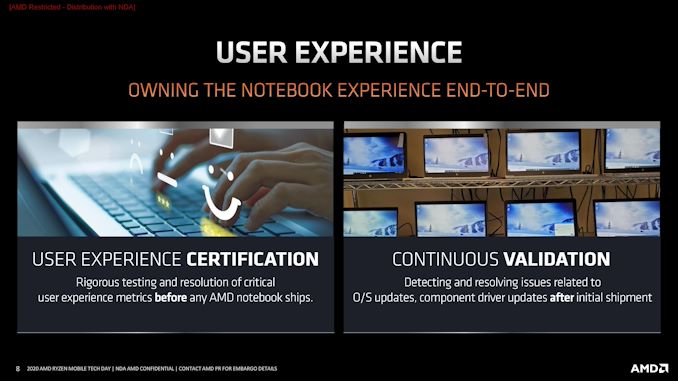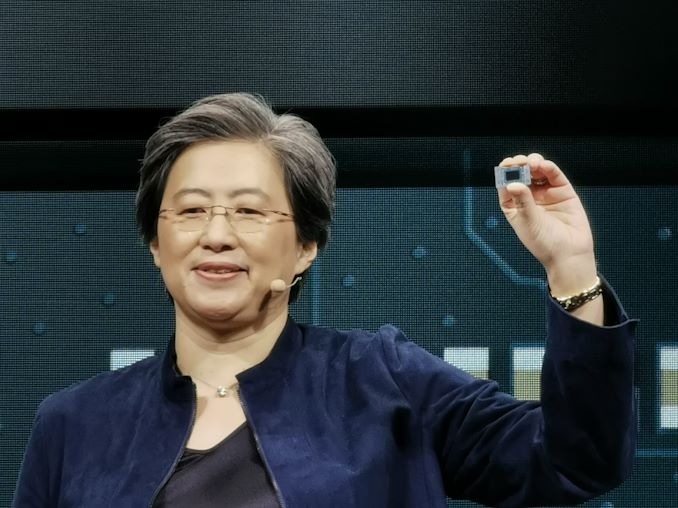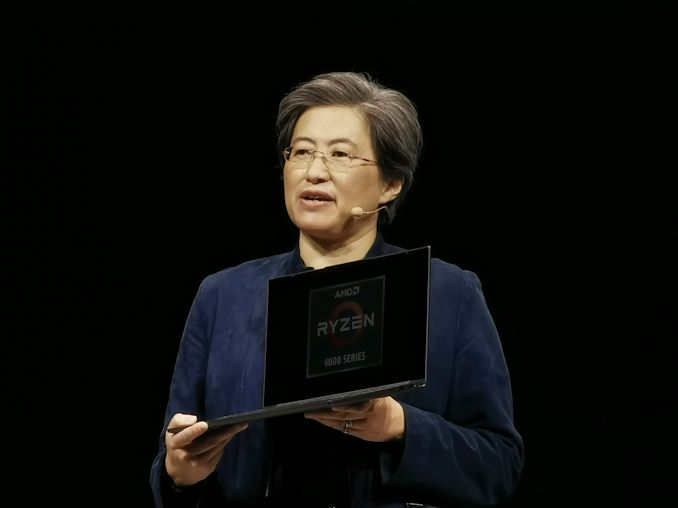AMD Details Renoir: The Ryzen Mobile 4000 Series 7nm APU Uncovered
by Dr. Ian Cutress on March 16, 2020 11:00 AM ESTThe Special HS Processors
As mentioned, at the top end of the new Ryzen Mobile 4000 list are the HS processors, offering almost exactly the same specification as the 45 W H-series processors, but at 35 W. AMD has marked these as special processors, not available to every OEM, because they fall under AMD’s new cooperative design and continuous validation programs.
In order to be able to use a HS processor, an OEM must work with AMD on the design. This is similar to what Intel does – ensure that the OEM partner gets the best from the hardware, and try and assist as to what design decisions the hardware was built for. Ultimately the product that comes out should be one that shows off the best of the hardware and gives the best user experience. On top of this, AMD has a list of ‘assured components’, validated to work against the new processors, and has created two continuous validation labs.
These labs, one in Austin and one in Shanghai, take the systems and pre-test all the new drivers and vendor software on them before they are released to the public. This is to ensure that the system is in no way compromised in performance, power, or thermals as a result of the update (to ensure that a company doesn’t completely mess with the power profile after it launches through a BIOS update or similar). AMD didn’t state how long its continuous validation program will run after the product is shipped, though I should think that at least 12-18 months should be plausible.
If the OEM does all this, and AMD agrees, then the product can use one of the HS processors.
(Note, the normal 45 W processors can be run in a 35 W mode, but just doing that doesn’t mean you can call it a HS. No doubt some third-tier OEM might try…)
The first HS-class system on the market will be the ASUS Zephyrus G14, and we learned in January that ASUS’s design has an exclusive for six months from launch. We’re expecting the G14 to hit the market in Q2, even with the current state of production, so we’ll see more HS models later in the year.
Conclusions
Ultimately today was the day that AMD was going to lift the embargo on Ryzen Mobile 4000 reviews, with the systems that AMD and its partners have provided. Due to the current ongoing issues around the world, those technical reviews of the systems will have to wait a few weeks while production is being ironed out. But for now we have a good grasp as to what AMD has pushing into the new processors coming out later this year.
Regular readers of AnandTech may remember back in 2016 I wrote a very long piece about AMD’s laptop strategy, where I tested five laptops from OEMs that were using AMD’s latest Carrizo APU at the time. The conclusions to that review were three fold: AMD was shooting itself in the foot by providing a platform that allowed its partners to be cheap; the OEM partners were being cheap by giving the hardware 13x7 screens, poor storage, poor trackpads and such because that’s all the customers seemed to want; and the customers were continually asking for cheaper systems, then getting frustrated with the poor user experience, ultimately blaming AMD rather than the OEM. It was a vicious cycle that required someone to break it.
Normally for these launches, a company will create a reference design for its partners to work with. AMD for years was creating these dull $500-$700 reference designs, which ultimately led to the paragraph above. We pled for generations for AMD to make a halo reference design, something ultraportable for $1500. For Renoir, given the reasonable performance uplift from the previous generation, the company worked with partners to create a range of high profile devices. I’ve covered a few of them in this article – the Lenovo Yoga Slim 7, the Dell G15 SE, and the ASUS Zephyrus G14 all attack different markets in very different ways, but all are examples of high-end products and design wins that AMD has needed in this market.
One of AMD’s big targets here is commercial. Despite the poor consumer performance of its older generations of laptops, the commercial laptop arm of AMD did reasonably well by comparison. AMD has announced its Ryzen Mobile 4000 Pro designs that afford admin control and sustainability over the lifetime of the product, and the key win here is that we’re seeing the processors in Lenovo’s Thinkpads, a key market.
The other big market is gaming. AMD can attack this on two fronts - the ultraportable market with the improved integrated graphics should get some good perfomrance, but also the more power hungry gaming market will get access to features like SmartShift to help balance the power between the APU and discrete GPU. AMD is also playing in the middle market here, with devices like the ASUS Zephyrus G14 with a HS processor and a Radeon RX5600M inside a 14-inch chassis, which AMD claims is the first 14-inch device with a H-class CPU and a discrete GPU inside. AMD's gaming team seem to be very happy with this design.
However, announcing systems is one thing. Deploying them is another. AMD has made a lot of claims about its Ryzen Mobile 4000 platform – performance, power consumption, and battery life. We’ve gone into detail into a lot of these, but we’re still missing one piece of the puzzle – the on-hand data. We’re hoping to get a system or two here in due course, and compare it against the competition.














95 Comments
View All Comments
Namisecond - Thursday, March 26, 2020 - link
Are you sure you don't mean an XPS 15 rather than the 13? The 13's have traditionally use U-class processors rather than H-class.deksman2 - Monday, March 16, 2020 - link
The iGP should be about 30% faster than Zen+.AMD improved Vega iGP uArch in Zen 2 mobile, so that per core, that Vega is now 56% faster than Zen+.
The Zen 2 mobile Vega iGP does apparently have lower amount of compute units, but because of improved performance per core, the iGP should still be about 30% faster than previous iterations.
So, yes, I do think games set to Medium settings and 1080p should work fine... more to the point, since these APU's also apparently support LPDDR4 with high frequencies, bandwidth won't be a problem... so hypothetically at least we could see even better performance.
Those improvements that went into Zen 2 mobile Vega will also be integrated in RDNA2.
LittlePaul - Monday, March 16, 2020 - link
I am wondering on the top left of the die shot, it looks like 64-bit GDDR6 controller comparing to Navi 10 die shot (exactly the same and way different to Piccasso )I am dreaming, right?
Spunjji - Tuesday, March 17, 2020 - link
Isn't that the CPU cores? Pretty sure that's what it is.uibo - Monday, March 16, 2020 - link
The Renoir APU graph on the first page has a block called "video codec next 2". I thought the engine was called "Video core next"?edzieba - Monday, March 16, 2020 - link
Note that AMD have chosen power-under-load as their look-at-the-big-number-we-have 'slide headline' figure, whilst the killer when it came to battery life for Ryzen Mobile 2xxx/3xxx was idle power.Fataliity - Monday, March 16, 2020 - link
There are slides on other sites, like notebookcheck.com and the video from the australians (hardware unboxed i think) That show the actual slides, and the data AMD themselves got.1065G7 still wins in some idles, but renoir pulls ahead in actual use it seems. Which evens out to about equal / slightly better for Renoir, depending on how you weigh it.
Spunjji - Tuesday, March 17, 2020 - link
They mention a number of improvements to idle, too - particularly from the Infinity Fabric, which was their big weakness before.anonomouse - Monday, March 16, 2020 - link
" Compared to the desktop design, the mobile is listed as being ‘optimized for mobile’, primarily by the smaller L3 cache – only 4 MB per quad-core group, rather than the 32 MB per quad-core group we see on the desktop"Isn't it 16MB per CCX on desktop?
Farfolomew - Tuesday, March 24, 2020 - link
I saw that too and questioned its validity. 32mb per 4-cores? That seems really high (I can't remember what it was reading the Zen2 desktop review last year) and if it's the case, that's a huge cut down for the mobile line